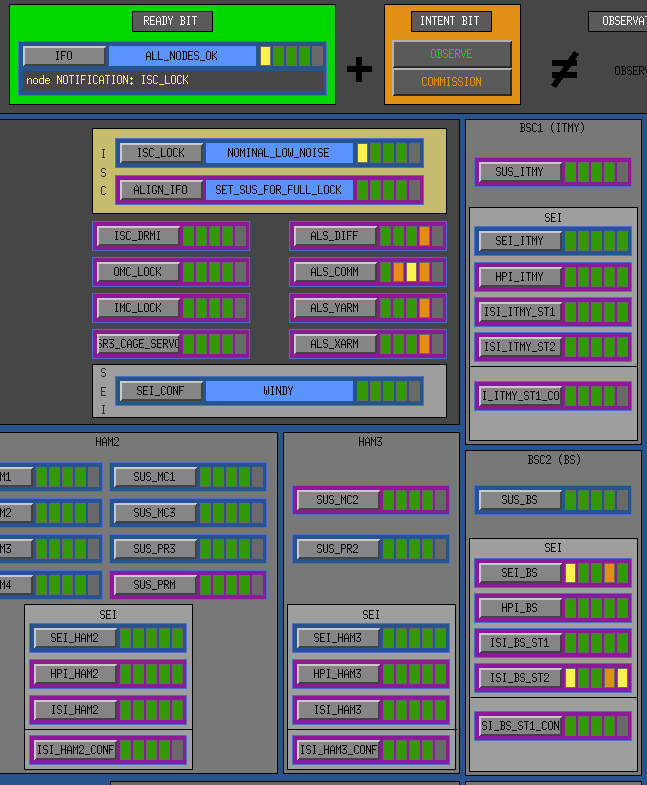The IFO top node appears to be not monitoring some SEI BS and ALS nodes. The IFO top node is reporting OK, even though multiple nodes are not reporting OK:

This is an indication of two issue:
- IFO top node is not monitoring SEI BS nodes, as well as some of the ALS nodes.
- If the SEI BS and ALS nodes are in their desired states, then their NOMINAL states are not set correctly.
The USERAPPS/h1/guardian/IFO_NODE_LIST.py that is in the SVN shows that those nodes should be managed, so my guess is that what's currently running has not been committed to the SVN.
My advice would be to not focus too much on a potential O2 configuration, but focus instead right now on the ER9 configuration. There's no problem in updating the NOMINAL states as needed. They should be set to whatever is appropriate for ER9, and make sure they're all monitored by the top node. We can then adjust things as needed for O2.
In other words, IFO should always be monitoring all nodes, and we should just adjust the NOMINAL state for each node to reflect whatever is the ideal IFO configuration at the moment.
I confirmed that the USERAPPS/sys/h1/guardian/IFO_NODE_LIST.py file has indeed been modified locally to remove monitoring of the SEI BS and ALS nodes, and that those changes have not been committed to the SVN.
Many guardian files have local modifications that have not been committed to the SVN:
jameson.rollins@operator1:~ 0$ guardlog list | xargs -l guardutil files 2>/dev/null | sort | uniq | xargs -l svn status
M /opt/rtcds/userapps/release/als/common/guardian/ALS_COMM.py
M /opt/rtcds/userapps/release/als/common/guardian/ALS_DIFF.py
M /opt/rtcds/userapps/release/als/common/guardian/ALS_YARM.py
M /opt/rtcds/userapps/release/ioo/common/guardian/IMC_LOCK.py
M /opt/rtcds/userapps/release/isc/common/guardian/VIOLIN_DAMPER.py
M /opt/rtcds/userapps/release/isc/h1/guardian/BOUNCE_ROLL.py
M /opt/rtcds/userapps/release/isc/h1/guardian/ISC_DRMI.py
M /opt/rtcds/userapps/release/isc/h1/guardian/ISC_library.py
M /opt/rtcds/userapps/release/isc/h1/guardian/ISC_LOCK.py
M /opt/rtcds/userapps/release/isc/h1/guardian/lscparams.py
M /opt/rtcds/userapps/release/isi/h1/guardian/ISI_BS_ST1_CONF.py
M /opt/rtcds/userapps/release/isi/h1/guardian/ISI_BS_ST1.py
M /opt/rtcds/userapps/release/isi/h1/guardian/ISI_BS_ST2.py
M /opt/rtcds/userapps/release/isi/h1/guardian/ISI_ETMX_ST1_CONF.py
M /opt/rtcds/userapps/release/isi/h1/guardian/ISI_ETMX_ST1.py
M /opt/rtcds/userapps/release/isi/h1/guardian/ISI_ETMX_ST2.py
M /opt/rtcds/userapps/release/isi/h1/guardian/ISI_ETMY_ST1_CONF.py
M /opt/rtcds/userapps/release/isi/h1/guardian/ISI_ETMY_ST1.py
M /opt/rtcds/userapps/release/isi/h1/guardian/ISI_ETMY_ST2.py
M /opt/rtcds/userapps/release/isi/h1/guardian/ISI_HAM2_CONF.py
M /opt/rtcds/userapps/release/isi/h1/guardian/ISI_HAM3_CONF.py
M /opt/rtcds/userapps/release/isi/h1/guardian/ISI_HAM4_CONF.py
M /opt/rtcds/userapps/release/isi/h1/guardian/ISI_HAM5_CONF.py
M /opt/rtcds/userapps/release/isi/h1/guardian/ISI_HAM6_CONF.py
M /opt/rtcds/userapps/release/isi/h1/guardian/ISI_ITMX_ST1_CONF.py
M /opt/rtcds/userapps/release/isi/h1/guardian/ISI_ITMX_ST1.py
M /opt/rtcds/userapps/release/isi/h1/guardian/ISI_ITMX_ST2.py
M /opt/rtcds/userapps/release/isi/h1/guardian/ISI_ITMY_ST1_CONF.py
M /opt/rtcds/userapps/release/isi/h1/guardian/ISI_ITMY_ST1.py
M /opt/rtcds/userapps/release/isi/h1/guardian/ISI_ITMY_ST2.py
M /opt/rtcds/userapps/release/isi/h1/guardian/SEI_CONFIG/const.py
M /opt/rtcds/userapps/release/isi/h1/guardian/SEI_CONFIG/CS_states.py
M /opt/rtcds/userapps/release/isi/h1/guardian/SEI_CONFIG/HAM_states.py
M /opt/rtcds/userapps/release/isi/h1/guardian/SEI_CONFIG/manager.py
M /opt/rtcds/userapps/release/omc/common/guardian/OMC_LOCK.py
M /opt/rtcds/userapps/release/sus/common/guardian/SUS_PI.py
M /opt/rtcds/userapps/release/sys/common/guardian/IFO.py
M /opt/rtcds/userapps/release/sys/h1/guardian/DIAG_MAIN.py
M /opt/rtcds/userapps/release/sys/h1/guardian/IFO_NODE_LIST.py
jameson.rollins@operator1:~ 0$
The lack of monitoring some nodes was at my request. These are nodes that currently are requested to be different from their true nominal state so that we can get diagnostic information (ALS nodes), or to avoid unneccessary potential locklosses (BS ISI node). For O2, these will be placed back in their low noise nominal modes. We removed them from the monitoring so that we would be able to set the Intent bit to Observe for the ER run. Once ER9 is complete, we will uncomment the nodes so that they are back to being monitored.
We should indeed be better about checking things into the svn.
I comitted these except for the isi ones




















